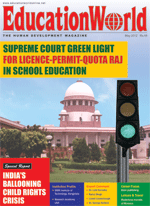 Compliments for your in-depth analytical cover story on the Supreme Court’s verdict on the Right to Education Act (EW May). Now I have no doubt in my mind that what ails our educ-ation system, specially at the primary and secondary levels, is too much government control which the recent Supreme Court’s majority judgement has sanctified. The “control and command” policy of the education establishment is certain to discourage private entrepreneurship in education, leading to rise in costs of schooling and corruption.
Compliments for your in-depth analytical cover story on the Supreme Court’s verdict on the Right to Education Act (EW May). Now I have no doubt in my mind that what ails our educ-ation system, specially at the primary and secondary levels, is too much government control which the recent Supreme Court’s majority judgement has sanctified. The “control and command” policy of the education establishment is certain to discourage private entrepreneurship in education, leading to rise in costs of schooling and corruption.
I totally agree with the dissenting judgement of Justice Radhakrishnan that “this objective (of quality inclusive education) could have been attained by arousing the spirit of voluntarism within private independent schools”.
There are a large number of excellent schools across the country which of their own volition — long before the RTE Act was legislated — have been admitting underprivileged children by granting scholarships and freeships. In the Lawrence School, Sanawar we not only subsidise children whose parents cannot fully afford our fees but also grant scholarships to meritorious children and from defence services households. Moreover from last year we have adopted several orphaned child-ren who receive equal education here free of charge. I am sure there are many other private schools which fulfil their social obligation in their own quiet ways.
Praveen Vasisht
Headmaster
Lawrence School, Sanawar
RTE real objective
Thank you for your detailed cover story on the Supreme Court’s judgement which ill-advisedly upheld the RTE Act (EW May). I have yet to read as clear and lucid an explanation of the issues involved as in your brilliant narrative. It’s now crystal clear that the real objective of the RTE Act is to close down budget schools which have emerged as competitors to dysfunct-ional government schools.
With the apex court having exempted minority schools from the impact of the Act, and having permitted the closure of private budget schools, now children of the poor will have no alternative but to attend government schools where they will learn nothing. It’s surprising the wise judges of the Supreme Court couldn’t see through this cunning strategy of the political class to keep the poor trapped in poverty and ignorance.
B. Devaiah on e-mail
Forced responsibility
Re your may cover story, the Supreme Court has approved by a majority of two against one, reservation of 25 percent seats for poor neighbourhood children in all unaided non-minority private schools in the country. Though the motive of this provision in the RTE Act is good, its application to private schools is questionable. The dissenting judgement of the third judge brilliantly articulates why it’s unfair for government to outsource its obligation of providing all children free primary education, to private schools.
Implementing the reservation provision will also have direct financial implications for parents as the cost of educating the 25 percent quota students will have to be borne by the remaining 75 percent. The responsibility to educate poor children cannot be forced upon individual citizens.
Three years after passing of the RTE Act, quality education is not yet within the reach of every child in this country. This is because of the dearth of good government schools. Reservations won’t solve this problem.
Mahesh Kapasi
Delhi
Appreciative words
Read with great interest your cover story on the RTE Act (EW May). The way you have explained the historical mess-up of our educational system, your grasp of the subject and the clarity with which you elucidated the issue is remarkable. Congratulations for a great effort.
Moreover, your courage in submitting that the majority judgement of Chief Justice Kapadia and Justice Kumar may be based on flawed logic and praying for a review by a larger constitutional bench has to be appreciated.
More power to you. Best wishes to EducationWorld.
Krishna Bhupathi
Bhupathi Tennis Academy Pvt. Ltd
Bangalore
Appalling neglect
The child health, nutrition and education statistics provided in the special report ‘India’s ballooning child rights crisis’ (EW May) are horrifying.
In every aspect of child care and protection, there’s appalling neglect, abuse and corruption. Persistent female foeticide, malnutrition, violence against children, sexual abuse and inhuman conditions prevalent in juvenile homes, etc — the list of child abuse cases seems to be unending. The plain truth is that India cannot dream of super-power status if its children are being driven to starvation, deprivation and felony in such huge numbers.
The only solution is for the Central and state governments to cut wasteful expenditure to release resources for child nutrition, health and protection. It’s time the world’s largest importer of arms and ammunition puts the welfare of children high up on the national agenda. Every child has a right to food, shelter and education, and it’s the duty of parents, government and society to ensure these rights are delivered to them.
Anjali Kalathur
Bangalore
Dr. Samanta’s miracles
I just read your cover story on the KIIT group of education institutions (EW April). I wish to acknowledge your efforts to bring initiatives such as these, which are doing an excellent job, to the attention of the masses.
I have personally visited KIIT and witnessed the miracles made possible by Dr. Achyuta Samanta. It’s a matter of great pride to have men like him among us. Such projects should be encouraged by society as well as government. I wish him all success and also hope to see more such articles in your magazine.
Vishwas on e-mail